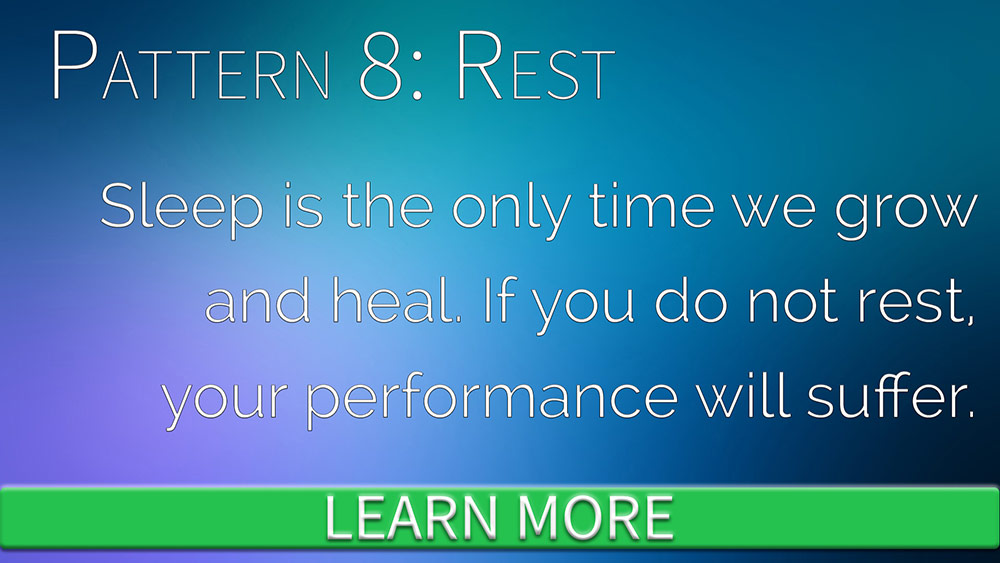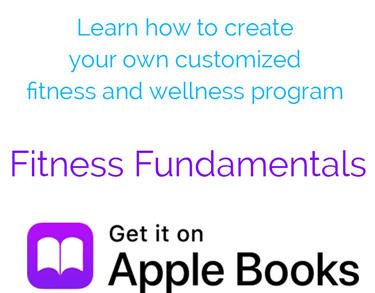The 8 Patterns of Fitness
In this series, I’m going to share some thoughts about the eight patterns of Integre8t Fitness. With these fundamentals in place, you can expect to see enhanced results from your mobile personal training plan. These concepts apply to all fitness and wellness programs. They are the patterns of your lifestyle. Within eight weeks, you can begin to make infinite progress.
#8Patterns1Lifestyle
#8WeeksInfiniteProgress
An introduction to Rest
The eighth pattern is rest. It encompasses more than sleep, although that’s the most fundamental element of this practice. Sleep, fasting between meals, time between sets during exercise sessions, days between training, personal time, play: All of these (and more) are opportunities to give yourself the ability to process and recover from all the living you do. As with everything, there’s a balance: Too little rest, and you’ll undermine everything else you’re trying to accomplish. Rest too much, and you won’t accomplish much of anything at all (which could be good, given the circumstances of a particular situation).
Sleep
Each person needs a different amount of consistent sleep to feel refreshed. Journaling tracks patterns, and how often you veer from them. Honestly, I veer so much so frequently that I know this will be my most challenging pattern for a while. Small steps!
Sleep hygiene is of the utmost importance. Your bedroom is for sleep and intimacy only. Avoid bringing electronics into your sleep space. If they have to be there, power them off. Remove any sources of blue light. Blue light signals your brain that dawn is coming, which then turns off the production of sleep hormones. Work is to be done outside the bedroom, reading included. Set your devices’ screens to shift colors to night mode in the hours leading up to bedtime, and avoid looking at them for 15 minutes before laying down for the night.
Sleep is sacrosanct. It’s the only time you heal and grow. Your mental computer needs to do a memory transfer and dump. Muscles have to stitch themselves back together. Your spirit needs time to drift away from the headlines on the news. Without sleep, you’ll undermine your performance across the board. It’s so important that I bought a Petcube to keep Ophelia entertained at night away from my bedroom door! Also, if you get Seasonal Affective Disorder during winter, you might want to consider these 14 alternative to caffeine when you need to maintain energy without upsetting your sleep pattern.
Fasting
I’m going to take a position that will offend many personal trainers: Eating six small meals per day is ridiculous (unless under a doctor’s order). Stop doing that. You won’t lose fat eating that way. If you always eat, you’ll always have elevated insulin and cortisol levels. Allow your digestive tract to rest, and let your body have a chance to access the energy it’s stored. I recommend intermittent fasting to those whose metabolisms allow it. I personally prefer the 8:16 model (eat all your daily calories during an eight-hour window, fasting four hours before that window and fours hours after it, and then sleep eight hours).
Rest between sets
This is a place where people often have too much rest. If your exertion is low, your rest between sets should be short. The harder you work the more rest you should take. For endurance training, take no more than one minute of rest between sets. For hypertrophy, aim for two or three minutes. And for strength training, which is intensely draining, plan for up to five minutes of rest.
Rest between sessions
Beginners and those who don’t exert themselves particularly intensely, can exercise more often. They should probably be doing full body circuits, or something that includes at each session all the major muscle groups. They don’t have to heal as much, so they should train much more frequently, even daily. At such low intensities, it’s fine doing strength and conditioning on the same days. Do first the activity that is a higher priority for your goals, so that you’re at full energy capacity when you do it.
Those at the intermediate level need more rest. Depending on the intensity of the sessions, activities will need days of separation. Conditioning at greater speed, distance, and/or resistance will need to start being separated from strength training, so that both can be performed at higher standards. For strength, create a simple split, so that each muscle group is worked two or three times during the week. If you do both strength and conditioning the same day, begin with strength training. End with conditioning.
For those who are advanced, generally speaking conditioning and strength should be kept separate on alternating days to allow the central nervous system time to heal. At this point, you’re likely to be working out to an intensity that requires multiple days of rest between sessions. You’ll be conditioning so hard that you probably shouldn’t think of doing strength the same day, and vice versa. For strength, you’ll need to split the body into more and more specific days, so that each muscle group is hit hard only one or perhaps two times per week. At this point, I really do recommend you not do conditioning and strength during the same session or even on the same day. This is especially true if you do high intensity interval training and/or high volume strength patterns.

Personal Time
Each person needs some waking time to think, breathe, and refocus. Working at anything repeatedly to the point of exhaustion is very destructive to wellness. You have to accept that your mind and body (and spirit if you want to go to that level) need short opportunities to recover. Often you’ll come back to your maximum ability after only a little time, and this allows you to be far more productive than running marathons on a daily basis. Take breaks!
Play
This itself may or may not be restful, depending on what you’re doing; however it’s vital to let off steam doing something you truly enjoy. If you work hard, you should play hard (and sensibly), and then you’ll need to rest hard. As with anything, balance and moderation are important, so choose your play wisely, and then enjoy it to the maximum. Once you come down from the high, be sure to leave plenty of time to find stillness. Play, like work, makes demands on you, and you need enough sleep after both.
4 Sessions per Month
Save $100- Free Evaluation
- $100 per session
- 1 session/week
8 Sessions per Month
Save $140- Free Evaluation
- $95 per session
- 2 sessions/week
12 Sessions per Month
Save $220- Free Evaluation
- $90 per session
- 3 sessions/week
Recent Updates

Glycemic Index vs Glycemic Load
This score indicates how damaging a food will be to your blood sugar levels. Foods that score 0-55 are rated low impact (and thus presumed to be better for diabetics and those looking to maintain healthy weight and/or body fat ratios), but this is not the whole picture.

Caffeine: 14 better options to ease SAD
Nearly a year ago to the dot, I wrote an article about Seasonal Affective Disorder (SAD), but there I focused on the importance of getting access to a full range spectrum of light. Here I’d like to focus on caffeine and sleep’s effect on SAD. I’ll also offer suggestions for what to do to help you feel better on the dark days.

Avoid fish oil supplements
I don’t generally promote supplements. Most of them play to specific, isolated points of medical research to serve as a magic pill. One remarkable example of this is fish oil.



